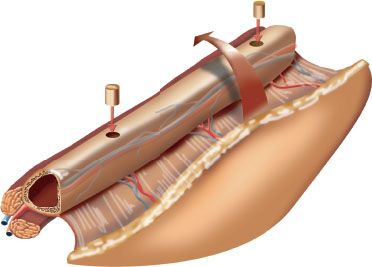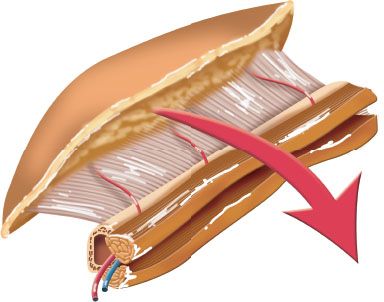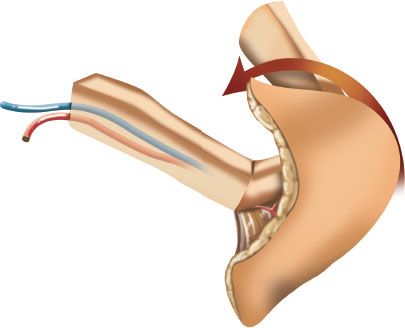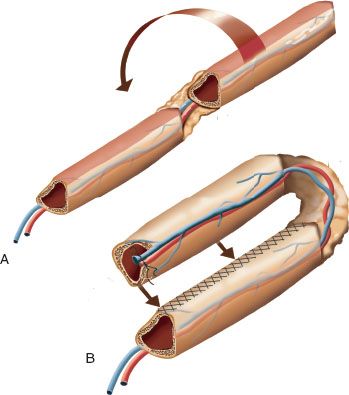FIGURE 14.1 Leg flexed at the hip and knee illustrating flap harvest positioning. Note that the posterior crural septum starts near the junction of the proximal and middle thirds of the fibula and diverges posteriorly from the fibula as it runs to the distal leg. The most reliable cutaneous perforators traverse this septum, and any skin paddle should be oriented over the septum and not the fibula. Six centimeters of fibula should be preserved proximally and distally to ensure knee and ankle stability. The location of the peroneal nerve is indicated.

FIGURE 14.2 A right fibula osseocutaneous flap in its natural orientation illustrates the peroneal vascular pedicle from the proximal lower leg. The flat lateral border of the fibula is best suited for plate and screw fixation and therefore the best surface of the lateral aspect of the neomandible. The anterior aspect of the fibula is ideal for intraoperative placement of osseointe-grated implants. The peroneal vascular pedicle can be seen coursing along the posteromedial aspect of the fibula between tibialis posterior and FHL muscle remnants. Cutaneous perforators can be seen traversing the intermuscular septum on the posterior aspect of the fibula. The arrow illustrates the limited arc of rotation of the skin paddle dictated by the length of the cutaneous perforators when the skin paddle is rotated anterior to the bone. This is not of concern when the soft tissue defect is extraoral or intraoral only to the floor of the mouth. More medial intraoral defects demand a better flap orientation.

FIGURE 14.3 A right fibula osteocutaneous flap rotated 180 degrees along its long axis, still illustrating the peroneal vascular pedicle from the proximal lower leg. The lateral aspect of the right fibula (the lateral aspect of the neomandible) is now oriented toward the left, and the posterior aspect of the fibula is uppermost. Osseointegrated implants can be placed in the posterior aspect of the bone, but placement should be delayed. Intraoperative implant placement in the posterior bone increases the risk of vascular compromise to the flap. The arrow illustrates the much more generous arc of rotation of the skin paddle available when the skin paddle is rotated posterior to the bone. This rotation is better suited for reconstruction of more lingual (medial) defects. Figures 14.2 and 14.3 together illustrate only two of the four variables available within each leg during preoperative selection of which leg to harvest. These two variables, anterior surface of the fibula placed superior or inferior in the neomandible, are doubled when one turns the entire flap around end-to-end. Remember, depending on available recipient vessels, the vascular pedicle can exit the neomandible posterior or anterior in the neck and if anterior can be anastomosed to ipsilateral or contralateral neck vessels. These variables (options) are then doubled again if both legs have potential for a fibula flap.

FIGURE 14.4 A right fibula osseocutaneous flap used to reconstruct an angle-to-angle mandibular defect, requiring significant soft tissue replacement of both intraoral and facial defects. The flap has been designed around a major cutaneous perforator that is associated with that portion of the fibula used to replace the anterior mandible. The intermuscular septum proximal and distal to that perforator has been sectioned allowing the skin paddle to rotate 90 degrees on the bone axis illustrated by the arrows. For large mandibular defects, requiring most of the fibula, the vascular pedicle always exits the neomandible posteriorly.

FIGURE 14.5 A. Illustration of a right fibula following ostectomy. Note the preserved periosteum and associated soft tissues with peroneal vessels supplying both the proximal and distal segments of bone. Note the flat lateral aspect of the fibula will be used as the lateral aspect of the neomandible. The arrow illustrates the intention to double barrel the fibula relocating the anterior aspect of each bone segment (shaded) into opposition. Ideally, the anterior aspect of each bone segment would have the periosteum incised longitudinally and reflected medially and laterally to expose the bone to be opposed. B. Illustration of the intended double-barrel procedure. Arrow illustrates the intended opposition of the denuded anterior surfaces of each fibula segment. Note that sufficient bone has been removed to allow repositioning of the segments without undue traction, torsion, or compression of the peroneal vascular pedicle connecting the two. Sufficient bone removal allows this soft tissue envelope containing the peroneal vascular pedicle to be positioned medial to the cut ends of both bone segments at the turn, avoiding potential compression at the interface between the double-barreled fibula and the native mandible.
The Variables
• The bone defect: Is it a lateral, anterior, posterior, or combination of defects? How long is the defect? Will there be sufficient fibula for the double-barrel technique? Is there a defect that involves the condyle?
• The soft tissue defect: How large is the defect? Is it intraoral, facial, or through and through? Does the anterior soft tissue defect extend to both mandibular body segments? Is the oropharynx involved in the defect?
• Vessel availability in the neck: Ipsilateral, contralateral, or bilateral availability? What is the recipient vessel proximity to the neomandible? (Important in the vessel-depleted neck) Preoperative CT neck with contrast can be helpful.
• Cutaneous branch(es) of the flap. How many? Septocutaneous or musculocutaneous? Location (proximal, mid, or distal)? Is there more than one skin paddle available? Doppler or CT angiography of the legs can be helpful.
• Geometry of the flap: The peroneal vascular pedicle can be brought off the neomandible posteriorly, anteriorly, or go to the contralateral neck. This is the variable over which the surgeon has the greatest control and therefore will receive the most attention in preoperative planning. To best visualize this 3D plan, the beginning surgeon should make the templates as illustrated in (Figs. 14.2 and 14.3) (cut them out if helpful).
• Assessing the bone and soft tissue defects and keeping the constants always in mind, the variables can then be systematically assessed to determine the best leg from which to harvest the fibula flap.
SURGICAL TECHNIQUE
Flap Harvest
Minor variations in technique for the fibula flap harvest exist but represent inconsequential personal preferences in my opinion. The common features must include an anterior and posterior dissection, fibula section, and distraction and pedicle vessel dissection. I prefer the leg to be flexed at the hip and knee with a pressure pad protecting the heel. The dissection is done under tourniquet at 350 mm Hg.
The fibula is outlined with indicators for preservation of 6 cm of proximal and distal fibula. The posterior crural septum is marked for resident education, and the location of cutaneous perforators is identified by Doppler (even if location confirmed earlier by imaging and already marked on the skin). The flap is designed to include these cutaneous branches in a size and design to fulfill the needs of the reconstruction. Whether elliptical or rectangular, the long axis of the skin paddle is centered over the posterior crural septum, not over the fibula.
The anterior incision is made through skin and subcutaneous tissue. Even if the skin paddle is designed in the distal leg, the skin incision is extended proximally to the point where the proximal osteotomy cut is to be made (preserving 6 cm of proximal fibula). For wide flaps, the skin paddle is initially elevated from anterior to posterior in a suprafascial plane until over the peroneus longus muscle. This protects the superficial peroneal nerve in the lower leg. At that point, the fascia over the peroneal musculature is incised and the skin paddle is reflected posteriorly in a subfascial plane to demonstrate the anterior aspect of the posterior crural septum. For narrow flaps, the anterior skin incision is already over the peroneal muscles, so it can be extended through the skin, subcutaneous tissue, and fascia in one step. In both wide and narrow flaps, once the posterior crural septum is exposed, the septocutaneous branch(es) are evident. The delicate paratenon over the tendon of peroneus longus muscle should not be disturbed and should not be allowed to dessicate, as both insults will compromise potential skin grafting over the muscle. I like to reinforce the skin markings with the perforators in clear view since later in the case vasoconstriction can make them less obvious. The peroneal muscles are then dissected off the lateral fibula from posterior to anterior. Care must be taken near the septocutaneous perforators at the posterior margin of the bone as these can send branches anteriorly into the peroneal muscles. Control of these branches is best accomplished a few millimeters away from the septocutaneous vessels to avoid vasospasm. The periosteum of the fibula should be left undisturbed. Anterior reflection of the peroneal musculature for the entire length of the bone to be harvested reveals the anterior crural septum. This is incised close to the fibula over the entire length of the bone to be harvested. Hugging the bone, the muscles of the anterior compartment are released from the fibula, exposing the interosseous membrane on its medial aspect. This membrane is similarly incised close to the fibula over the entire length of the bone to be removed. Careful attention must be paid to any anterior retraction of the peroneal muscles in the proximal wound as the peroneal nerve can be damaged. The anterior dissection is now complete. Some surgeons like to cut and distract the fibula at this point, but I prefer to do the posterior dissection first.
The posterior skin incision is made and carried through the subcutaneous tissue and fascia with attention to preserve the sural nerve and saphenous vein intact if possible. The subfascial dissection then reflects the skin paddle anteriorly over the gastrosoleus muscle but not all the way to the posterior crural system. I prefer to now bluntly dissect into the avascular plane between the FHL and the soleus muscles in the distal wound. I then place a finger in this space directed proximally and separate the muscles carefully from distal to proximal looking for septomusculocutaneous perforators that might pierce the soleus muscle. If encountered, I reflect the skin paddle posteriorly and anteriorly, assessing the anterior and posterior aspects of the posterior crural system to get a clear picture of the septocutaneous branches. This allows me to determine if preservation of a small cuff of soleus muscle would provide more cutaneous blood supply. If so, a small cuff of soleus is excised around such perforators and left with the skin paddle. If no such perforators are found, the soleus is separated completely from the FHL and, more proximally, from the posterolateral aspect of the proximal fibula. Also in the proximal lower leg, if I am harvesting a skin paddle based on musculocutaneous perforators, these are dissected and preserved at this time. In either case, separation of the soleus from the proximal fibula exposes the posterior aspect of the proximal fibula. The peroneal vascular pedicle can be now seen as it courses distally disappearing under the most proximal fibular attachment of the FHL. I then incise the fascia on the posterior aspect of the FHL. This maneuver releases the posterior tibial neurovascular pedicle from its close association with the medial aspect of the FHL, reducing risk of inadvertent injury. The posterior dissection is now complete.
Stay updated, free articles. Join our Telegram channel

Full access? Get Clinical Tree


